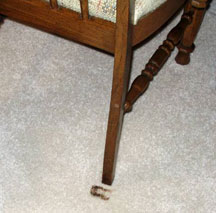Leather terms and Types of Leather
- Split: All leather hides have to be split into two hides because a hide is too thick to upholster or use in any type of manufacturing. The bottom hide is known as split leather. This hide can be sanded down (corrected) and embossed with a consistent graining pattern to be used on the outside back and sides of sofa for a slight cost savings. A split leather is still 100% leather, and has all the same finishing treatments as the top grain portion.
- Top Grain: In the above process the top grain portion is the top portion of the hide. It is generally used in the areas that receive more wear since the fiber of top grain is more compact than that of split grain.
- Full Grain: Top grain leather that uses the grain of the hide. No correction is made to the grain.
- Embossed Grain: From above, using rollers a consistent graining pattern is “pressed” into the leather. It can be as subtle a small natural looking graining pattern, or as different as a crocodile pattern.
- Corrected Grain: This leather is top grain aniline dyed leather. Small natural markings and scars are sanded from the hide and then it is pigment coated for color consistency. Then a clear protective top-coat is applied to prevent fading and stains.
- Pull-up: Aniline - dyed leather that has been waxed or oiled. When the leather is pulled, the oil/wax separates, causing the color to lighten.
Cleaning and Care of Pure Anilines and Nu-Buk Leather Upholstery
You’ll notice that leather initially repels most spills, but if left to stand, they’ll be absorbed. That’s why it is important to blot any liquids immediately with a clean cloth or sponge and let air dry. Most spills and stains will dissipate with time. For stubborn spots and stains, blot excess liquid immediately with clean absorbent sponge or cloth. If you need more help, use distilled water and a clean white cloth and let air dry. Use soap sparingly and lots of distilled water. Always test a hidden area to convince yourself of the effectiveness of that method.
LEATHER WILL ABSORB OILS. Appropriate preventative care must be taken to avoid these stains as they may be permanent.
Leather Upholstery Care and Protection
- As a general rule, most leather creams, saddle soaps, and various leather care products should not be used. They are not intended for household, upholstered leather.
- Dry clean with chemical sponges, and/or towels with solvent. Finish as needed with a cream or oil-based leather cleaner applied by hand.
- Simulated Leather (Vinyl/Naugahyde) and non-woven materials made to look like leather should be wet cleaned only. If solvent is used for spotting, it must be used extremely carefully and must not contain any chlorinated solvents.
Upholstery Cleaning, Protection and Maintenance Articles:
- Microfiber Furniture Care
- Upholstery Care and Cleaning





 Free packet of information about Bane-Clene can be obtained by calling toll-free 1-800-428-9512 (U.S. ONLY!). Your information packet will include a full color catalog and price addendum. Packets will arrive in approximately 2 weeks through standard United States Mail.
Free packet of information about Bane-Clene can be obtained by calling toll-free 1-800-428-9512 (U.S. ONLY!). Your information packet will include a full color catalog and price addendum. Packets will arrive in approximately 2 weeks through standard United States Mail. “A to Z” Alphabetical Index to the Bane-Clene Web Site
“A to Z” Alphabetical Index to the Bane-Clene Web Site Bane-Clene Home Page
Bane-Clene Home Page







